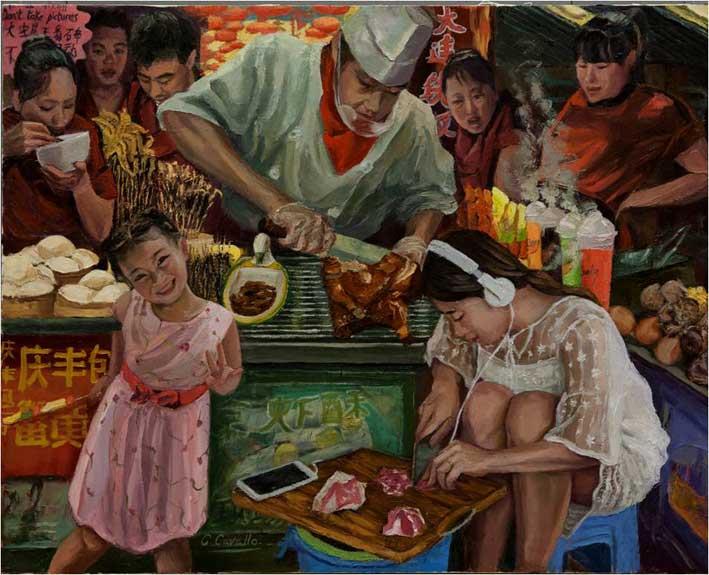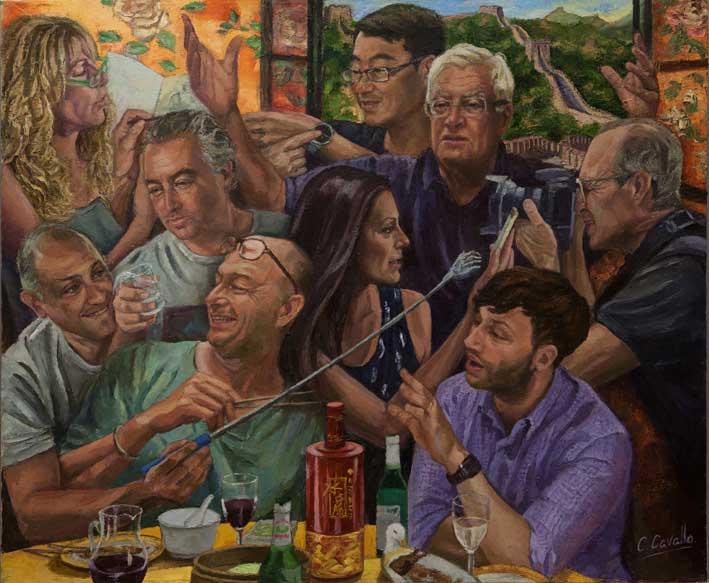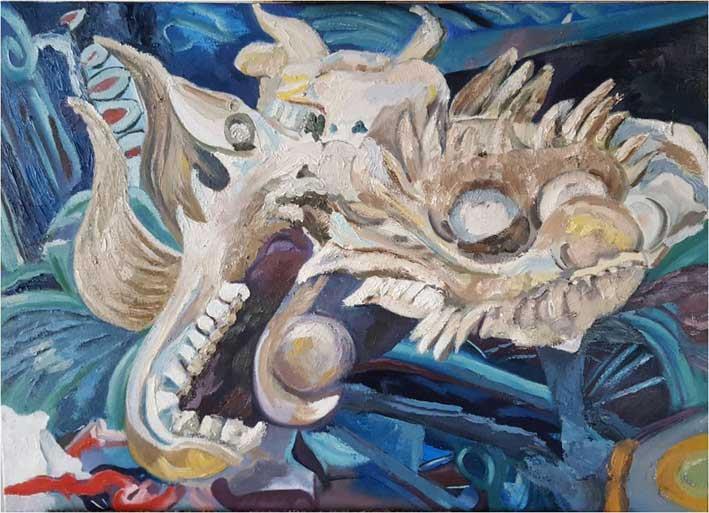Gazing thoughtfully at the exhibits making up Inspired in China - Fine Art Exhibition by Maltese Artists, I could not help thinking of these works of art travelling up and down the Silk Road - an ancient route which for centuries signified the economic and cultural interaction between China and the Mediterranean. For this, the fifth exhibition of its kind, also marked the 45th anniversary of the establishment of diplomatic relations between the People's Republic of China and the Republic of Malta.
As explained in the exhibition's brochure - produced by H.E. Mr Jiang Jiang, China's Ambassador to Malta - on 31 January 1972, the leaders of that older generation 'with their extraordinary political wisdom and strategic vision, decided to establish diplomatic ties between the two countries, thus opening a new chapter in the annals of their bilateral relations.'

When the then Prime Minister Dom Mintoff visited China, that important political act was deemed to be the first ever official visit by a head of government from a Western-European country to the People's Republic of China. It was the time when this large Asian nation was gradually emerging from its self-imposed isolation and fate decreed that this tiny Mediterranean country gave its fullest support throughout the process leading up to China being accepted as a member of the United Nations.
In July-August of 2016, acting on an invitation of the Chinese Ministry of Culture, the Chinese Cultural Centre, in conjunction with the Arts Council, Spazju Kreattiv, the Art Discussion Group and the Mediterranean Conference Centre, invited local artists Catherine Cavallo, Alex Attard, Antoine Farrugia, Darren Tanti and Simon Barthet to visit China's thriving cosmopolitan capital Beijing and the prime heritage site that is the Province of Henan.

I viewed the exhibition at the fourth stop of its quite extensive tour at the Parliament of Malta in Valletta between 12 and 14 May. Curated by E.V. Borg from the Art Discussion Group, it will next be exhibited at the Ministry of Gozo in Victoria, where it will run from 4 August to 24 September.
The exhibition, with its 27 pieces, was initially on view at the Chinese Cultural Centre last December. From there it moved to SkyParks at the airport (from January to April), the Cavalieri Art Hotel in St Julian's (from April to May) before being transferred to Renzo Piano's oeuvre in Valletta.

Having made a point of talking to the participating artists, I was struck by their enthusiasm - which still bubbled, even some six months after the exhibition's first showing. They are all as pleased as Punch that their work, in various genres and styles, has succeeded in capturing some of the fascinating aspects that comprise China's unique confluence of multiple ethnic and regional cultures.
Describing Making Merry and the Great Wall of China, Catherine Cavallo told me: "Sharing an experience such as this very special trip to China brings you very close to the people you find yourself with. This trip was made all the more perfect by the company I was privileged to keep, and my travelling companions have now become very dear friends. They were a lively and spirited lot, with boundless energy and good humour; and great conversationalists too." Catherine confided that, from very early on in the trip, such a unique ensemble had to be represented and documented in a painting. So Catherine drew endless sketches and took many photographs from which she produced a most challenging painting that pleasantly surprised all and sundry when first exhibited.

Other works by Catherine included Lunchtime in Beijing - focusing on the fantastic food culture of China, The Grand National Theatre - ('a shimmering pearl rising out of a crystal-clear lake') and Opera House of Beijing. An emotional day shared with the Shaolin Monks resulted in Shaolin Kungfu ("I know there are more to come" the artist predicts). The vast lotus plantations in Haotang village gave rise to a study detailing the nature of leaves and flowers but, here again, Catherine senses the need to revisit the experience in a much larger and unruly future painting.
Noted photographer Alex Attard has made a name discovering and connecting the beautiful and the sublime, particularly in the unexpected and the overlooked. And his Chinese sojourn was clearly no exception. "If I had to put a name to this body of work, it would be: The Spirit of the Moment," he told me. Today, the Great Wall - designed to keep people out - welcomes thousands of tourists from all over the world. Alex's camera zones in on a designated graffiti zone in Mutianyu, where the name Trump crops up amongst the other scribbles.

Other highlights depict the Bird's Nest - the Olympic Stadium: a testament to modern China and one of the world's architectural wonders. Shot in-camera multiple-exposure series, which takes its cue from the building's Piranesi-like space and geometric structure, this intellectual approach bestows sensuous, tangible and physical wonder to these images.
The sculptor Antoine Farrugia has produced five interesting works. Inspired by Bird's Egg in Beijing and Inspired by a Megalithic Fossil, both in patinated globigerina limestone (franka) and mounted on hard stone and lava, demonstrate a rare delicacy and unique elegance, while Red Rock Mountain, Taihu Stones and The Great Wall of China exhibit a profound harmony that produces a musical and lyrical rhythm and are influenced by a mood that is essentially Chinese and both ancient and modern in expression.

The young Darren Tanti creates comparisons and contrasts: a modern Chinese woman standing next to a peasant woman from the Romantic period in The Young Shepherdess (originally by William Bouguereau). In Child, Darren fuses colour and monochrome in the digital merging of a boy by Rubens and an image of a Chinese boy who caught the artist's fancy. Again in another collage, Velasquez's famous painting La Meninas sits comfortably next to a mother and child separated by a laughing dwarf borrowed from Yue Minjun's famous painting.
The artist's objective lies in the bonding of east and west, contemporary and past masters while searching for a unification that defies time and space. By transposing European Art in a Chinese context, he could feel the two realities simultaneously, thus pointing to a universality in which he seems to be very comfortable indeed.
In Street Vendors, self-confessed food lover Simon Barthet creates a different world - with food stalls selling a vast array of curious and exotic foods. At the Shaolin School of Kungfu, when the headmaster displayed his skills in calligraphy, he was there to capture the moment in his effective Shaolin Master's Brushes and the Buddhist temples' remarkable culture features in Temple to Heaven.
And a brief interlude at the tranquil Haotang Village resulted in two more of Simon's landscapes: a fitting finale to this talented group's visual narrative of the Celestial Empire, so called due to the belief that the Divine has generously gifted the Asian giant with a rich and abundant culture that is second to none.